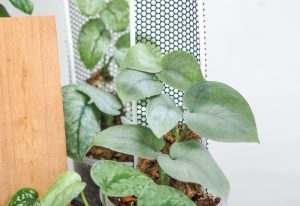Neon Pothos and Golden Pothos are two popular varieties of the Epipremnum aureum plant, known for their lush foliage and ease of care. While both have similar requirements for light and water, there are some notable differences in their appearance and growth patterns.
Neon Pothos Vs Golden Pothos
Differences in Appearance

Neon pothos is known for its bright, lime-green colored leaves which give it a neon-like radiance, making it an excellent choice for brightening up dark corners in a home. On the other hand, Golden pothos has larger leaves that display a mix of green and yellow variegation, creating a more classic appearance. The heart-shaped leaves of Neon pothos tend to be leathery and thin, with younger leaves showing brighter hues compared to the deeper tinge of neon in mature leaves source.
Growth Patterns and Size
Golden pothos generally has larger leaves than Neon pothos, with an average size of 3-4 inches both in length and width source. The growth pattern for both plants is quite similar since they are both vining plants, allowing them to be used as hanging plants or for trailing along shelves or other surfaces. Given their similar growth patterns, the main distinction between the two lies in their appearance and leaf size, making it a matter of personal preference for the decorative purpose one aims to achieve.
Ideal Growing Conditions
Both Neon and Golden pothos are relatively low-maintenance indoor houseplants, capable of adapting to various growing conditions source. However, there are some optimal conditions to keep in mind for each species.
Neon pothos thrives in warm, humid environments with temperatures ranging from 55 to 90 degrees Fahrenheit (15 to 35 degrees Celsius) source. In terms of lighting, it prefers bright, indirect light but can also tolerate low light conditions.
Golden pothos, on the other hand, also prefers medium to bright indirect light for supporting its variegation, although it can survive in low-light conditions if necessary source. It grows well in similar temperature ranges as the Neon pothos, making both suitable choices for indoor growing.
In conclusion, the Neon and Golden pothos are easy-to-care-for, adaptable indoor plants that can relatively thrive in varied conditions. Their primary differences lie in their distinct leaf colors and sizes, providing multiple options for indoor plant enthusiasts to choose from according to their home decor and personal preferences.
Caring for Neon and Golden Pothos
Watering Requirements
Neon and Golden Pothos have similar watering needs, as they both prefer evenly moist soil. However, it’s crucial to avoid waterlogged or soggy conditions, as these can lead to root rot (source). To ensure proper watering, wait until the top 2-3 inches of soil are completely dry before irrigating again (source).
Lighting Needs
Both Neon and Golden Pothos thrive in bright, indirect sunlight. They cannot tolerate excessive direct sunlight, so it’s essential to find a spot with the right balance of light (source). Although they prefer well-lit areas, they can adapt to lower light conditions as well (source).
Soil Mix and Fertilization
Choose a loose, well-draining potting mix for your Neon and Golden Pothos to prevent root rot and ensure healthy growth (source). As for fertilization, apply a balanced fertilizer periodically to support their growth. Be sure to follow the manufacturer’s recommendations for application rates and frequency.
Pruning and Propagation
Regular pruning of Neon and Golden Pothos promotes bushy growth and helps maintain plant health. Remove any dead or yellowing leaves and trim long vines to encourage new growth. For propagation, simply take stem cuttings with at least one leaf node and place them in water or soil. Keep the cuttings in a warm, bright location, and they will soon develop roots, giving you new Pothos plants to care for and enjoy.
Overall, Neon and Golden Pothos are relatively easy to care for, making them ideal houseplants for both beginners and experienced gardeners. By meeting their basic watering, lighting, soil, and pruning needs, you’ll enjoy their lush growth and stunning foliage in your indoor space.
Common Issues and Solutions
Pests and Diseases
Neon pothos and golden pothos generally face few pest issues, but they can be affected by mealybugs and scale insects. To treat these pests, spray the affected leaves with a neem oil solution once a week, ensuring that it covers all plant surfaces.
As for diseases, while these plants are not particularly susceptible, they can be affected by Southern Blight or Bacterial Wilt. If you notice any browning or dying leaves, it is essential to remove the affected parts promptly to prevent the problem from spreading.
Over/Under Watering
Both neon pothos and golden pothos prefer moist soil but are prone to root rot if left in waterlogged or soggy conditions. To avoid overwatering, wait until the top 2-3 inches of the soil become dry before watering again. Drooping leaves can be a sign of underwatering, so if you notice this issue, water your plant promptly, and the leaves should perk back up.
Yellowing Leaves or Stunted Growth
Yellowing leaves can indicate multiple issues. Occasional yellowing may be due to natural aging, but if multiple leaves yellow at once, it could signify a more significant issue. Both neon and golden pothos need bright, indirect sunlight, so ensure that they are in a well-lit area without direct sunlight.
Inadequate nutrients can also cause yellowing and stunted growth. If you suspect this is the case, apply an appropriate houseplant fertilizer to address the imbalance. Additionally, monitoring your watering habits and providing proper lighting conditions can help prevent yellowing leaves and stunted growth in both neon and golden pothos.
Benefits of Pothos in Your Home
Air Purification
Pothos, including neon and golden varieties, are known for their air-purifying abilities. They help to remove toxins such as formaldehyde, benzene, and xylene from the indoor air. This makes them an ideal choice for homes or offices where indoor air quality is a concern. By having pothos plants around, you can breathe easier knowing that they are working to clean the air for you.
Aesthetic Appeal and Versatility
Neon and golden pothos provide aesthetic value to indoor spaces with their distinct appearances. Neon pothos has bright chartreuse, heart-shaped leaves, while golden pothos has larger leaves with yellow variegation. These plants can significantly brighten up a room and add life to dull corners.
Both types of pothos are adaptable and versatile in terms of how they can be displayed. Some options include:
- Hanging pots for a cascading effect
- Plant totems or moss poles for vertical growth
- Tabletops, mantles, or windowsills for horizontal growth
Low Maintenance Nature
One of the key benefits of having pothos in your home is their low maintenance requirements. They can thrive in a range of temperatures, from 55 to 90 degrees Fahrenheit (15 to 35 degrees Celsius). Pothos plants can also tolerate low light conditions, making them suitable for almost any indoor space.
When it comes to watering, these plants prefer to dry out slightly between waterings. Overwatering can lead to root rot, which can ultimately be fatal. However, if you provide the right balance of water and light, you will have a healthy, thriving pothos plant with minimal effort.
By choosing pothos as an indoor plant option, you can enjoy the numerous benefits they offer, such as air purification, aesthetic appeal, and their low maintenance nature, all within the comfort of your home.
Helpful Video

My name is Daniel Elrod, and I have been houseplant love ever since I was 17. I love how much joy they bring to any room in the home. I’ve always been amazed at how a few pots of flowing leaves can turn a drab and sterile office into an inviting place where people love to work at.

















































































































































































































































